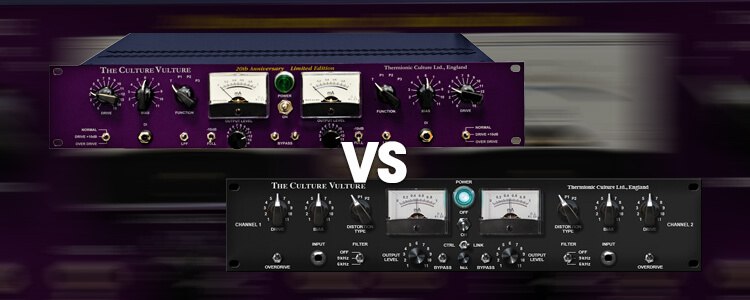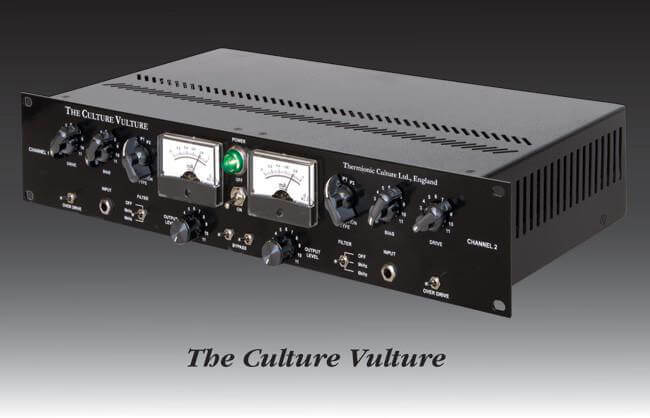Hardware vs Software: Thermionic Culture Vulture vs UA Culture Vulture
John Pickford traces the history of ‘the only pure valve distortion unit of its kind’, the Thermionic Culture Vulture, and meets its software equivalent from Universal Audio The original, and some would say, best Culture Vulture has since been reborn in both hardware and software Thermionic Culture manufactures some of the finest outboard gear available […]

John Pickford traces the history of ‘the only pure valve distortion unit of its kind’, the Thermionic Culture Vulture, and meets its software equivalent from Universal Audio

The original, and some would say, best Culture Vulture has since been reborn in both hardware and software
Thermionic Culture manufactures some of the finest outboard gear available and, as its name implies, all of it is driven exclusively with valves. I’ve used pretty much every model the company has produced, many of which I’ve reviewed for MusicTech.
The studio I use owns several units, namely the Early Bird and Rooster microphone preamplifiers, Phoenix and HG15 compressors, Freebird equaliser and the unit I’m revisiting here, the Culture Vulture. We also have the plug-in from Universal Audio which I will come to later.
Launched in 1998, the Vulture is a rack-mountable distortion unit and remains the only pure valve distortion unit of this kind. The range of harmonic distortion available is vast, providing everything from a gentle warming of signals – ideal for breathing life into sterile digital sources – through to full on sonic annihilation; it’s the ultimate audiophile distortion unit.
There are three settings to determine the style of distortion: T (triode) is the gentlest type, offering a musical warming of sounds associated with triode valves, while both P1 and P2 settings switch the distortion valve to Pentode mode. Pentodes add odd harmonics to signals, producing more aggressive effects, with P2 described by Thermionic Culture as the ‘No Holds Barred’ setting.
The input level of the signal sent to the 6AS6 ‘distortion’ valve is adjusted via the Drive control, while the Overdrive switch offers an altogether filthier tone. The distortion style can be further tailored with the Bias pot, which controls the current through the 6AS6 valve, as shown on the milliammeter.
At low settings the sound becomes thinner and broken up as the Vulture is starved of current. Medium current levels (0.25 – 0.3 mA) provide the least amount of distortion, adding lovely harmonics to warm up the signal, while higher settings create a fuller, fatter tone. High levels of distortion produce a prominent fuzzy treble that can be rounded off using the two-position Low Pass Filter, which curtails frequencies above 6 or 9kHz.
Thermionic Culture recently brought out a special 20th anniversary model – finished in purple – featuring an extra Pentode mode and populated with specially-selected Mullard valves. Gold-plated jack inputs are another special feature of this limited edition.

The 20th anniversary model complete with Mullard valves.
It isn’t the first special edition of the Vulture however; an 11th anniversary model featured seven additional distortion settings, while the Super 15 model also incorporated a 2-position presence control as well as variable mid-lift in Pentode mode. The discontinued Solo Vulture is a mono unit designed primarily as a guitar effects box, with several changes in the audio circuit though it retains the 6AS6 distortion valve.
The software
Universal Audio’s Termionic Culture Vulture plug-in is modeled on the classic Culture Vulture with three available distortion types. In use, it behaves just as the original unit though you obviously don’t get the warm glow of valves, and the chunky, retro pots and switches – so lovely to use on the hardware versions – are merely an image on a screen. We said in our review of it: “Detailed modeling with a CPU load to match, Culture Vulture is a perfect way of rounding off those digital edges, or simply creating a wall of noise!”

UA gets the Culture Vulture sound pretty much spot on
And as to which is best, you’d have to go for the hardware for that tactility but UA pretty much nailed it and we concluded that: “it’s certainly it’s hard to think of another plug-in that offers this level of authenticity and versatility in respect to valve-driven distortion, so if you’re a real overdrive junkie the Culture Vulture is not to be missed!”
20 tears after its launch, the hardware Culture Vulture remains the ultimate in valve-driven distortion. It delivers everything from a wonderful thermionic thickening of instruments, voices and mixes, to full on wasp-in-a-blender fuzz.